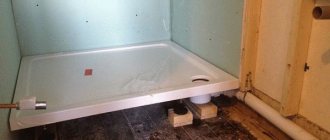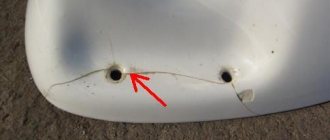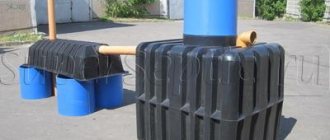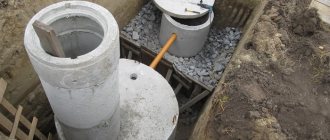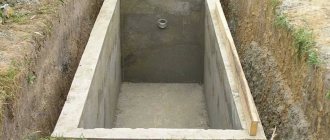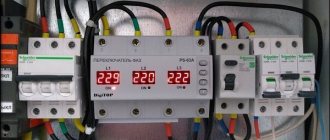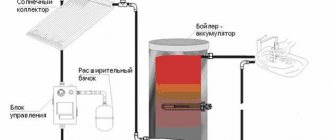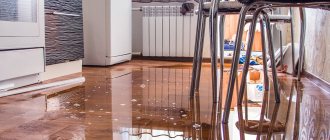A septic tank for a private home that does not require pumping is presented on the Russian market with standard, reinforced structures for permanent residence and temporary use. The product rating includes the most inconspicuous designs - complete absence of odor, minimal maintenance, small area of products, resistance to groundwater. Models for temporary use are inexpensive, can be installed and maintained independently. Devices intended for permanent residence are more demanding in terms of operating conditions - it is important to ensure the recommended minimum of wastewater and a stable supply of electricity.
How to choose the right septic tank for a private home
Residents select autonomous sewers individually for the operating conditions in a particular house. Important criteria are:
- Groundwater level, soil composition. For difficult soils, structures reinforced with stiffeners are suitable. If the groundwater level is high, preference should be given to the appropriate connection height for the incoming pipe.
- Performance. The daily volume of wastewater discharged determines the performance of the septic tank. One person drains 200 l/day into the sewer. A small family of 3 people will need a device that processes 0.6 m3.
- The material affects the service life and reliability of the septic tank. Polymer is considered the best option due to its low weight and low cost design.
Important! The quality of the septic tank determines the comfort of living of the guests of a private house.
Materials
You can make a septic tank with your own hands from various materials. They differ in quality, durability, cost and other factors.
Table. What can you build a septic tank from?
| Material | Characteristic |
| Reinforced concrete rings | Quite expensive, but one of the fastest septic tank options to build. The main work is the accurate calculation and installation of concrete rings. It is quite difficult to work with this building material on your own without special equipment, since the rings are heavy. Such a septic tank will have good tightness if assembled correctly. |
| Monolithic cement septic tank | A septic tank, which is a pit in which concrete walls are made using formwork and cement. After the poured cement has hardened, partitions are made in the pit, dividing the container into chambers. Such a septic tank is highly durable, lasts a long time, does not let water through, but is quite expensive and difficult to install. |
| Brick | A common, simple way to build settling tanks. Inexpensive, but durable and reliable. The walls are made of brick. Such a septic tank is reliable, durable, economical, but often may not be completely sealed and takes longer to build than a septic tank made of concrete rings. |
| Plastic containers | Fast and easy. Such a septic tank is made from Eurocubes, which were invented for transporting liquids in large volumes. It is reliable, airtight, inexpensive, but requires certain preparatory work, since the walls of the pit should be further strengthened so that they support the walls of the containers. Such septic tanks are not characterized by large volumes. Purchased septic tanks are also made of plastic. |
| Tires from car wheels | This is a great way to create a septic tank from scrap materials. Most often, it is built in this way at dachas where people do not live permanently. Very large tires are placed in the pits. But, despite its availability and low cost, such a septic tank has its drawbacks - it is not airtight enough and is short-lived. |
Comparison of septic tank Bars-Aero and Bars-Topas
Septon
Septic tank "Septon" - new for 2021! Serves 3-15 people. The station provides deep wastewater treatment thanks to bacteria contained in a separate block of the station for up to three months without the entry of organic matter. The model range of septic tanks without pumping is attractive with a variety of options with different capacities, volume of volley discharges, and insertion depth of the supply pipe. The “Smart” module (crushed stone-free drainage system) is optional.
Technological solutions for the best septic tank 2021
The Septon septic tank is made of homogeneous integrally foamed copolymer (polypropylene + ethylene) and can withstand operating temperatures of +40...-40˚С. The body is represented by a self-supporting cylindrical vessel equipped with a rectangular lid. The neck and lid are painted green. The round shape, one weld seam ensures long-term operation of the septic tank - 25 years. The product has minimal dimensions, occupying 2 m2 of area.
The wastewater is treated biologically using suspended activated sludge. Air is supplied by a membrane tubular polymer aerator. Nitrogen compounds are best removed during general biological treatment. Forced drainage systems are equipped with a built-in storage tank with a drainage pump. The liquid is disinfected with a built-in ultraviolet disinfectant. The GSM system (sold separately) notifies about changes in the operation of the septic tank and simplifies management.
The septic tank operates without noise, odor, and does not require pumping. The degree of wastewater recycling reaches 98%. Conversion of a gravity structure into a forced one is allowed. The absence of fragile parts prevents mechanical breakdowns.
Principle of aerobic biological action
Septon Smart septic tanks for private homes can withstand uneven flow of wastewater, operate effectively at low loads, and support the vital activity of bacteria during large burst discharges, eliminating the washout of microflora. Biological treatment, accompanied by oxidation with oxygen, reduces the BOD and allows clean water to be discharged without filtration fields.
Aerobic-anoxic wastewater processing allows activated sludge to absorb organic and chemical compounds in the presence or absence of dissolved oxygen. The sludge mass, incubated from bacterial strains supplied along with organic waste, forms colonies of bacteria in the form of flakes that are easily separated from clean water. Airlifts, which circulate the liquid with compressed air bubbles, help prevent the destruction of activated sludge flakes.
Contents of delivery
Basic modifications of Septon septic tanks without pumping include a housing, a compressor, a technical passport, and a 110x15° outlet pipe.
Forced drainage systems are additionally equipped with a storage tank, a good drainage pump with a float switch, a reinforced PVC hose, fittings and connectors.
Model range of VOC "Septon" for a private home
The Septon line includes septic tanks of gravity, forced type (PR), extended modifications “Long” (the entrance height is increased by 40 cm, the body length is increased by 50 cm). The numbers in the marking indicate the volume of salvo discharge. Technical characteristics of Septon allow you to choose the best solution for a private home or cottage:
200 SAM, PR - inlet tube depth 60 cm, number of users 3-4, peak discharge 200 l, daily productivity 0.6 m3. Dimensions: 85x85x228 cm, energy consumption 1 kW/knock.
250 SAM, PR - inlet pipe height 60 cm, 4-5 consumers, one-time water supply 250 l, capacity 0.8 m3. Dimensions of a popular modification for a private home: 90x90x228 cm, energy consumption 1.2 kW.
320 SAM, PR, Long - pipe insertion height 90 cm, recommended number of residents 5-6, one-time discharge 320 l. Minimum dimensions: 100x100x250 cm, best energy consumption - 1.6 kW.
500 SAM, PR, Long - connection of the pipe at a height of 90 cm, users - 7...8, one-time supply of liquid - 500 l. Basic parameters: 112x112x250 cm, electricity - 2 kW.
800 SAM, PR, Long - insertion height - 90 cm, consumers - 9...10, peak discharge - 800 l, standard tank dimensions: 155x155x250 cm, capacity 1.8 m3/day, energy consumption - 2.6 kW.
1000 SAM, PR, Long - connection depth 90 cm, residents of a private house - 15, capacity 3 m3/day. Basic parameters: 177x177x250 cm. Power consumption of a septic tank without pumping is 3.1 kW.
Price range: 77-180 thousand rubles.
With a water consumption of 200 l/day per resident of a private house, the septic tank completely processes waste within the established limits. Sludge is pumped out every 3-6 months. When concluding a service agreement, the manufacturer provides 2 free technical services and provides a 5-year warranty.
Autonomous sewage system Unilos Astra
The Astra septic tank is a functional installation that provides the technological process of wastewater treatment inside a sealed housing. The septic tank is suitable for cleaning wastewater from the kitchen, bath, toilet, jacuzzi, swimming pool, where effective disposal of liquid household waste is required. The manufacturer confirms the annual certification of the product in accordance with ISO 9001:2008 standards.
The choice of the Astra septic tank model for a summer house or country house is determined by a number of criteria:
- The amount of daily water consumption. Before purchasing a household structure, you should determine what is the generally accepted norm for one user (200 l), and multiply by the number of users. The result obtained will allow you to choose the right septic tank for your dacha, country house, cottage, or non-residential property.
- Type of soil. The soil has a high throughput capacity and does not require the use of pumps for forced drainage of liquid into a storage tank. Placing a septic tank in clayey and loamy areas requires connecting a built-in storage tank and pump (preliminarily determine which pump model to choose for a specific station).
- The need for further use of purified water. To improve the hygienic characteristics of water, the manufacturer suggests using additional equipment that disinfects wastewater with ultraviolet and ultrasonic action.
- The depth of the underwater pipe (when choosing a septic tank, you should take into account what height of the supply pipes is suitable for the “Standard”, “Midi”, “Long” series - 80 cm, 1 m, 1.5 m).
Advantages of Unilos Astra septic tanks:
- degree of purification of waste products - 95%;
- manufacturer's warranty - 10 years;
- completely sealed and waterproof;
- maintaining an optimal temperature regime for the liquid (+15…+17°C), eliminating the possibility of water freezing at the outlet into the filtration fields or storage tank;
- possibility of operation in difficult climatic conditions, in earthquake-prone areas;
- aeration processes provided by air filters neutralize unpleasant odors;
- the Astra septic tank consumes a small amount of electrical energy (which is especially beneficial for dachas);
- the aerobic system does not require the creation of post-treatment filters.
Below you can find out what prices are offered by the manufacturer of septic tanks Unilos Astra:
Astra-3 is a treatment facility that accepts a daily discharge of 0.6 m3, electricity consumption 0.06 kW/h, weight 140 kg, dimensions 820x1000x2000 mm, cost 58,900 rubles.
Astra-5 - 1 m3, 0.06 kW/h, 230 kg, 1040x1000x2360 mm, 71,200 rubles.
Astra-8 - 1.6 m3, 0.08 kW/h, 290 kg, 1500x1040x2360 mm,
89,590 rubles.
Astra-10 - 2 m3, 0.1 kW/h, 365 kg, 2000x1040x2360 mm, 107,900 rubles.
More information about the Astra septic tank
Septic tank "Topas"
"Topas" is the best biological wastewater treatment system developed by the group. The local station processes, clarifies, and disinfects sewage by 98%. Purification technology is achieved using active components: oxygen, bacteria that decompose wastewater into water and neutral sludge. Sludge masses act as binding components containing waste that resist bacterial attack. The waste liquid is suitable for watering plants on the site.
The processing of organic matter is achieved by anaerobic and aerobic bacteria. Life activity and wastewater processing with anaerobic particles are carried out in an oxygen-free environment of sealed containers. Aerobic bacteria require an unimpeded supply of oxygen. The microorganisms reproduce on their own, eliminating the need to regularly add bacteria to the wastewater. A septic tank differs favorably from ordinary cesspools in the absence of odor and the need to pump out waste using a vacuum cleaner.
Design Features
Externally, the Topas septic tank for a private house is represented by a rectangular container equipped with a square lid. The internal part of the structure is divided into four functional sections. The system is equipped with a surface air intake device that saturates the wastewater with oxygen.
A number of elements are provided inside the treatment plant:
- a receiving compartment that ensures the initial flow of wastewater;
- an airlift equipped with a pumping device to move liquid between individual chambers;
- aeration tank facilitating secondary purification;
- pyramidal chamber for final sewage treatment;
- a post-treatment chamber that accumulates water during operation of the septic tank;
- a compressor that pumps air;
- self-pumping sludge hose;
- clean water drainage device.
A separate section of the septic tank is equipped with the best compressors, distribution box, control unit, and electronics.
Technical characteristics, prices
The range of Topas septic tanks is quite wide. Small models serve summer cottages and private houses; more powerful systems (“Topas” 10-40) are successfully operated by gas stations; large stations (“Topas” 50-150) are able to satisfy the needs of small villages. Residents of private houses often choose Topas 4-10 models. The number indicates the approximate number of users.
"Topas 4" serves 4 people. The volume of processed liquid is 0.8 m3/day, incoming waste water is 175 l/time. System dimensions (LxWxH): 95x97x250 cm. The best price for the device is 95,000 rubles.
“Topas 5” is the optimal option for servicing 5 users consuming 1 m3/day with a one-time discharge of 220 liters. Device dimensions (LxWxH): 110x120x250 cm. Price range - 109...150 thousand rubles.
"Topas 6" satisfies the needs of 6 people. The daily load of the system is 1.15 m3, one-time load is 250 l. LOS parameters (LxWxH): 115x117x255 cm. Price range: 112-153 thousand rubles.
Topas 8 is suitable for 8 users. Recommended fluid consumption is 1.5 m3/day; the system can withstand a flow of 440 liters at a time. Station dimensions (LxWxH): 160x120x250 cm. The best modifications of “Topas 8” cost 129-178 thousand rubles.
Topas 9 recycles wastewater from 9 people. The daily norm is 1.7 m3, salvo discharge is a maximum of 510 liters. Basic dimensions (LxWxH): 163x117x255 cm. Price range: 132-187 thousand rubles.
Topas 10 is effectively operated by 10 users. VOC discharges 2 m3/day, providing a one-time supply of 760 liters. Dimensions of the basic model (LxWxH): 160x120x250 cm. Price variability: 168-233 thousand rubles.
Individual designs also have a letter meaning: the “Long” series is distinguished by an elongated neck, “Pr” indicates the presence of a built-in pump, “Us” is a reinforced system that facilitates the expansion of water treatment plants.
Septic tank users note high operating efficiency, no need for additional treatment, pumping out water, as well as compact dimensions and the possibility of installation on various soils. The septic tank manufacturer guarantees ease of maintenance, quick preservation, and restoration of VOC operation.
Let's consider the design of the device
The construction of external sewerage has the sole purpose of getting rid of human waste products. But before doing this, it is necessary to ensure the safety of the wastewater so as not to pollute the water that has yet to be used.
Traditionally, cesspools were used for this purpose to accumulate waste. Depending on the intensity of use, such devices require regular pumping of the contents; according to SanPin standards, such an event should be performed at least once every six months or when full.
Watch the video - operating principle, diagrams and experience of using sewerage without pumping
SEPTIC - PRINCIPLE OF OPERATION, DIAGRAM, EXPERIENCE OF USE. Sewerage without pumping. High groundwater
In some cases, the regularity of such an operation occurs within a month or two, and its cost ranges from 12,000 rubles.
The main components of a storage tank with pumping are:
- A durable sealed housing capable of holding contents without penetrating into the ground outside the cesspool. To do this, you need to thoroughly waterproof it.
- Natural tank ventilation system. When storing fecal waste, methane gas is formed, which in a certain proportion with air is a flammable or explosive mixture that must be regularly released from the chamber.
- Double cap on the neck. Internal wooden and external metal or plastic.
- A drain pipe through which wastewater flows from the internal sewer system to the external one.
The principle of constructing a septic tank without pumping is somewhat more complicated, since the processes occurring in wastewater during its processing are important.
Therefore, the main components of such devices are:
- Drain pipe between the exit from the building and the storage tank of the external sewerage system. Its diameter should be 100-110 millimeters, length at least 10 meters. For financial and technological reasons, plastic products are usually used.
- Next comes the storage tank, which performs several functions. The first is crushing the drain stream, for which a baffle plate is used, which directs the stream down and crushes it. In this case, heavy inclusions settle to the bottom, where they are processed by aerobic bacteria.
- When the liquid level rises to the overflow pipe, it begins to flow into the second container. An air atomizer and a low-power compressor for pumping atomized air are installed in it.
The sufficiency of oxygen in wastewater triggers the work of aerobic bacteria, which additionally process organic matter in the liquid being purified, bringing its degree of purification to 98-99%.
Further, various devices can be used in the form of chlorine cartridges, UV emitters, additional filters for final cleaning and disinfection of the drain.
"Tver"
The Tver septic tank is a reliable, efficient treatment facility, equipped with a 4-stage filtration system. Allows you to drain waste water onto the terrain, into the nearest body of water, excluding the construction of filtration fields. A variety of bio-loading gives better performance when used constantly in a private home, or in a country house - it does not require pumping. Small sizes and the presence of lugs are key selection parameters for high groundwater levels. The performance results of current samples have been confirmed since 1993.
Model range of septic tank "Tver"
The model range of autonomous sewerage meets many user requests. A small family, a bus station or a cafe, a large entertainment complex - the Tver septic tank satisfies various requirements. On the Russian market, the manufacturer of autonomous stations presents more than 44 variations of VOCs.
Cleaning systems for a private home without pumping are marked with letter signs to ensure the correct choice:
“P” – polypropylene structure, reinforced with metal belts. The tube is located in the body at a height of 30 cm. A lower location of the pipes requires a neck build-up.
“M” is a model that provides a pipeline depth of 60 cm.
“PN” - a septic tank for a private house is equipped with a pumping chamber that forcibly pumps water into the well. The connection depth of the pipe is 30 cm.
“NP” - the device is supplemented with a good drainage pump; wastewater is forced into the treatment system. The supply pipe is laid at a depth of 112 cm.
“PM” - the model is distinguished by extended sides. Allows you to supply water at a height of 60 cm.
“NPM” - the design combines extended sides and a pump for forced supply of wastewater for cleaning. The depth of the supply pipe is 142 cm.
“NPNM” - the device is equipped with two pumping chambers. Ensures forced flow of sewage into the treatment system and pumping of clarified water from the septic tank. The depth of placement of the sewer pipe is 132-172 cm.
Internal structure, principle of operation
Structurally, the Tver septic tank is represented by 6 chambers:
- Septic compartment. Department for receiving wastewater from the supply main. Promotes gravity cleaning.
- Anaerobic reactor. Processes sediment using special brushes, creating an oxygen-free environment for fermentation.
- Aerotank. Forced air supply and active purification of organic matter with sludge are the main tasks of the chamber.
- Sump. The liquid undergoes additional sedimentation of suspended particles.
- The bioreactor subjects the liquid to final purification from toxic nitrogen and phosphorus compounds.
- Stabilizer. Here the wastewater is once again settled before being discharged.
The standard time for processing household waste is 3 days. During this period, the wastewater undergoes gravitational settling (heavy fractions precipitate, the remaining liquid is subjected to further processing), oxygen-free fermentation under the influence of anaerobic bacteria, and purification with activated sludge.
The best septic tank modifications for a private home
Septic tanks "Tver" for a private cottage, dacha, are presented in the following options:
“Tver” 0.35 is a compact product that processes 350 l/day with a compressor power of 40 W. Easily disposes of wastewater from 2 people using a sink or toilet. The device is characterized by small dimensions (cm): 140x110x167, weight 90 kg. Price: 74,000 rubles.
“Tver” 0.5 is the best solution for small private houses providing permanent or periodic residence for 2-3 people. Operating parameters VOC - 500 l/day. The device can withstand the simultaneous flow of water from a household bathtub. The model weighs 100 kg, small dimensions (LxWxH) 165x110x167 cm increase ease of transportation and installation. The VOC costs 81,800 rubles.
"Tver" 0.75 is distinguished by a high degree of wastewater processing - 750 l/day, volley discharge of 250 l. The light weight of the unit (120 kg), dimensions (190x110x167 cm), and the possibility of placement at a distance of 5-10 m from the house often induce families of 4 people to choose a septic tank. Buying a septic tank without pumping will cost 93,200 rubles.
“Tver” 0.85 easily serves 3-5 users, with a daily water consumption of 850 liters and a burst discharge of 235 liters. Basic device parameters (cm): 215x110x167, weight - 130 kg. Cost - 100,400 rubles.
"Tver" 1 locally cleans the wastewater of 6 residents. The daily performance of the drainage system reaches 1 m3/day; the treatment unit processes 300 liters at a time. The weight category of the unit is 150 kg, dimensions: 260x110x167 cm. Price: 112,000 rubles.
"Tver" 1.2 is recommended for families of 5-7 people. The deep biological treatment station can withstand an influx of 1200 l/day, and a one-time discharge of 450 l. The product weighs 200 kg, corresponds to the parameters 280/110/167 cm. Cost: 121,600 rubles.
Septic tank "Tver" 1.5 will increase the convenience of country living for 9 people. The declared capacity is 1500 l/day, simultaneous discharge is 450 l. Weight 250 kg, dimensions 340/110/167 cm. Price: 136,300 rubles.
"Tver" 2 is designed to process sewage for 10-12 people. Capacity - 2000 l/day. Space dimensions: 400x130x167 cm, weight - 310 kg. Base price: 169,800 rubles.
The manufacturer's website also offers larger versions of household septic tanks - Tver 3, 4, 6, industrial models: Tver 10-200. The choice of treatment facilities manufactured by , is justified by reliability and simplicity of design. The presence of stiffeners simplifies the installation of a septic tank in difficult soils. The absence of thin pipes and the gravity movement of wastewater inside the tank prevents blockages.
Principle of operation
The operating principle of a septic tank, equipped according to all the rules, is a complex scheme, as a result of which the negative impact on the soil and the environment is minimized. According to the traditional scheme, a septic tank is a treatment facility, and it looks like a device of two or three chambers. The first container is a storage facility for waste directly from the sewer line.
This is where the mixture decomposes. In the chamber, the wastewater breaks down under the action of bacteria into a sludgy substance and settled water.
IMPORTANT! The first tank should be of such a volume that it is enough for use for three days, during which the mass decomposes.
After the water has settled and purified a little, it flows into the second chamber - the filtration well. If the first container is made hermetically according to SNiP, then the second one must be made with a drainage bottom (crushed stone, gravel or sand). Water passes through the drainage, is filtered and absorbed into the ground, thereby not polluting it.
Scheme of a simple septic tank with soil-based wastewater treatment Source roomester.ru
Filtering fields: application features
The filtration field is a more complex engineering structure than the FC, which cannot be called compact, but it can also be used in areas with high groundwater level and a large volume of wastewater, more than a cubic meter per day. True, not every soil is suitable here; nevertheless, it must filter well. Most often, filtration fields are made in loamy soil.
The filtration field is a system of perforated pipes with a diameter of 110 mm (you can take ordinary plastic sewer pipes and make cuts in them) at a depth of at least half a meter with a slight slope.
How to create a proper filter field:
- make a cushion of crushed stone and gravel with a height of 0.2 m;
- lay pipes;
- cover again with crushed stone and gravel, the height of the layer is 10 cm above the top of the pipes;
- cover with a geomembrane;
- cover with soil.
To correctly calculate the number and length of pipes in such a sewerage scheme for a private house, you need to take into account two parameters: the volume of wastewater and the filtering properties of the soil. Pipes can be positioned in different ways, but the more branched and longer the pipeline, the better the cleaning will be.
There is a simple table that allows you to make an approximate calculation of the filtering field. It is easy to use: the top line shows the volume of the septic tank, and the type of soil in the left column. If the type of soil on the site is sandy loam, the volume of the septic tank is 5 cubic meters, then at least 5 meters of pipes are needed.
For constructing a filtration field for a household septic tank, such a table is quite sufficient.
The downside of the filtration field is that it always “bites off” a significant piece of the area, at least 30 square meters. And the biggest advantage of using this system, besides the high quality of cleaning, is durability; the filtration field silts up after approximately 10 years of service.
Infiltrators and drainage tunnels
In small areas, the installation of filtration fields is impossible, and the optimal solution here may be the use of ready-made infiltration or drainage tunnels.
They are installed one or two meters from the septic tank, and one such device with a volume of 300 liters replaces about 36 meters of drainage pipes and 800 kg of crushed stone. Externally, the ecnhjqcndj looks like a large container without a bottom; in some models the walls are perforated, in others they are solid (but then a perforated drainage pipe is built into the design).
Miket78FORUMHOUSE Member
Infiltrators form a cavity located underground into which water flows after the septic tank. The water goes into the ground - the cavity is freed. To ensure the required performance, it is not the number of septic tanks that is important, but the absorbency of the soil.
Individual modules of drainage tunnels can be easily assembled with each other into a structure of the required volume. They are installed in the same way as filtration fields, deepened at least half a meter from the surface of the earth, but covered on all sides and on top with a layer of sand or soil at least 50 cm thick.
How many times a month does the drive need to be pumped out?
These are sealed plastic containers that are buried in the ground on the site and receive wastewater from the house. Provided production and installation technologies are followed, they are safe from an environmental point of view and do not pollute groundwater.
But the main ❌ minus of storage devices is the need for regular pumping.
At the current level of comfort, the average daily water consumption per person is 200 liters. These figures are derived from experience and are confirmed by the Soviet SNIP 2.04.03-85, where for apartments with hot water supply and shower, water consumption per person per day is set at 195 liters.
Therefore, a family of 5 people. per day will spend 1000 liters or 1 cubic meter. You can try to save money. But still, less than 15-20 cubic meters of sewage, if you count it per month, will not work.
The average volume of a vacuum truck is 4-5 m³. There are more capacious models based on KAMAZ, which take up to 10 m³, but they do not go to calls everywhere.
As a result, even with KAMAZ trucks, a family of 5 people will call a sewer truck at least 2 times a month❗
The price for such a tanker and a similar pumping volume will start from 4,000 rubles or more, if you take the real cost, and not fancy advertising from the Internet. Vacuum truck trip = departure of a large truck to order, which will then transport waste weighing 10 tons to the landfill. Alas, something like this simply cannot cost 1000 rubles; even the fuel will not pay for itself. After calculating the costs, we get:
A family of 5 people in a house with all the amenities will spend 8 thousand rubles a month or more on servicing the drive!
Aerotank
This device differs from a septic tank with a biofilter in that the “working force” of the aeration tank is aerobic bacteria - that is, microorganisms that ferment in an oxygen-saturated environment.
Wastewater is pumped into the aeration tank by airlifts - special lifts that operate using compressed air.
Next, the wastewater is mixed with sludge, in which bacteria and protozoan microorganisms freely exist, and the oxidation process begins. Sewage and sludge are additionally mixed using aerators - special devices that add more oxygen to the water and speed up the process.
The effluent treated with sludge is transferred further. In the next section, the water is separated from the solid part of the wastewater and sent to the outlet. And the sludge that settles to the bottom returns back to the bacteria in the aeration tank.
Scheme of the Topas treatment plant
A septic tank with a biofilter has advantages over an aeration tank. Firstly, it does not work from the mains and does not depend on turning the electricity on and off. Secondly, it is more convenient to use: bacteria for the biofilter can simply be poured into the drain, and they themselves will find their way to their place of settlement.
The aeration tank is advantageous in that it does not need to be additionally insulated during the cold period, and wastewater treatment in it occurs faster and better than in a septic tank with a biofilter. Both types of bioseptic tanks require special maintenance. Be sure to call the sewer trucks once a year to pump out the sediment from their sedimentation tanks. In addition, the septic tank with a biofilter must be cleaned of excess bacteria, which can excessively silt the backfill. Dead sludge must be removed from the aeration tank. This procedure can be carried out independently: a special pump is built into the aeration tank system for this case. Airlifts and aerators also require annual cleaning.

